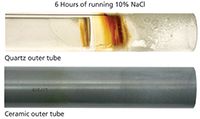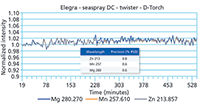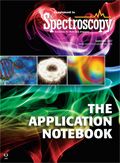Article
Application Notebook
Application Notebook
Considerations When Analyzing Real-World Samples by ICP Spectrometry
Author(s):
Dealing with a sample matrix high in total dissolved solids (TDS) is a common challenge for ICP spectrometry. Most "real samples" contain considerable concentrations of TDS including soils, sludge, waste water, brines, high acid digests, and fusions. The challenges encountered include interrupted runs, signal drift, clogged nebulizers, shortened torch life, and greater interferences. To overcome these challenges, it is essential you select a proper sample introduction system so that you can achieve the best performance your ICP-OES or ICP-MS can provide. In this article, a complete sample introduction package is presented to improve ICP performance in a high TDS sample matrix.
An argon humidifier is essential and one of the most important accessories for ICP-OES and ICP-MS analyses involving samples with high TDS. The added moisture in the nebulizer gas helps to reduce salt deposits in the nebulizer and torch injector, allowing uninterrupted operation. In addition to the argon humidifier, a large bore injector is recommended, typically, greater than 1.5 mm ID for radial view ICP-OES instruments and greater than 2.0 mm ID for axial view ICP-OES and ICP-MS instruments. Due to the rapid devitrification of quartz in the presence of high TDS, a demountable ICP torch is preferred to reduce replacement costs. A nebulizer capable of handling high TDS should be chosen and combined with a baffled cyclonic spray chamber to eliminate large droplets from reaching the torch. Below we will describe in detail the characteristics of each of these essential high TDS components.
Argon Humidifier
The Elegra™ argon humidifier, released in February 2016 (1), utilizes highly efficient membrane technology to add moisture to the argon as it flows through the inert metal-free construction. The device runs at atmospheric pressure and does not require heating or electric power, as required by other manufacturers. The Elegra is also configured with a bypass switch so that the operator can turn humidification on and off without connecting or disconnecting any tubing. The elegant design results in a very compact accessory that is simple to install.
A nebulizer stress test was completed aspirating a 25% NaCl solution while monitoring the nebulizer gas flow with and without the Elegra (Figure 1). A decrease in gas flow is a good indicator that a nebulizer is clogging. Note a nebulizer with a TDS tolerance rating of only 5% was used to illustrate the advantage of the Elegra. As a worst-case test, the salt solution was aspirated continuously, with no rinsing. As expected, without the Elegra, the nebulizer was completely clogged after only 5 min. In contrast, the same nebulizer with the Elegra, held a relatively constant gas flow throughout the entire test (over 30 min). A similar result was also observed with the injector (1).

Torch Selection
The combination of high temperature and salt deposits causes a quartz torch outer tube to devitrify, resulting in frequent replacement of the entire torch. The D-Torch™ offers an affordable, robust demountable ICP torch design which greatly reduces consumable costs. With the D-Torch the outer tube can be replaced when worn and the optimum injector can be selected for each application. The D-Torch also incorporates a ceramic intermediate tube for greater robustness.
Unique to the D-Torch is an optional ceramic outer tube, which does not suffer from devitrification. In Figure 2, a quartz outer tube is compared to a ceramic outer tube, both of which have been exposed to 6 h of running 10% NaCl. You can clearly see that there is no change to the integrity of the ceramic outer tube, whereas the quartz is severely devitrified.

A detailed performance evaluation of the fully ceramic D-Torch was presented in a 2010 application note (2). In this report, the D-Torch exhibited exceptional stability in the presence of 3% NaCl and provided equivalent analytical performance to a standard quartz torch.
Spray Chamber Selection
Glass Expansion spray chambers are specifically designed to provide high performance and fast washout (3). The Twister™ cyclonic spray chamber is the ideal choice for high TDS applications due to its central transfer tube (baffle). The baffle acts as a secondary droplet filter to reduce droplet size and plasma loading without compromising detection limits yet improving precision (%RSD). The reduced sample load helps to increase torch life, slow salt build-up at the injector tip, and decrease the frequency of cleaning ICP-MS interface cones.
Nebulizer Selection
The SeaSpray™ nebulizer comprises a unique self-washing tip designed to prevent crystal growth, providing a tolerance of up to 20% TDS. The SeaSpray's popularity is due to its ability to offer outstanding nebulization efficiency for trace level analyses combined with excellent precision and a high tolerance to TDS.
To evaluate the performance of the SeaSpray DC nebulizer a 1 ppm multielement standard was prepared in a 3.5% NaCl matrix and aspirated at 1 mL/min for 9 h with no rinsing. The combination of the SeaSpray DC nebulizer, Twister spray chamber, ceramic D-Torch, and Elegra argon humidifier provided exceptional stability (Figure 3). A measurement was taken approximately every 3 min over a period of 9 h, while a precision of less than 1% was maintained throughout the experiment.

Conclusions
An easy way to eliminate drift, interrupted runs, and frequent maintenance to your ICP sample introduction system is to add the Elegra argon humidifier. The D-Torch offers an affordable, robust ICP torch design while greatly reducing torch consumable costs. The optional ceramic outer tube for the D-Torch provides a significant improvement in torch life and stability in the presence of high TDS. Combining the SeaSpray nebulizer with the Twister spray chamber will provide optimum sensitivity and exceptional long-term precision even in the presence of high TDS.
References
(1) Glass Expansion February 2016 Newsletter, "The Elegra Argon Humidifier: Uninterrupted and Maintenance-Free ICP Operation."
(2) Thermo Fisher Scientific Technical Note #43053, "Radial Demountable Ceramic Torch for the Thermo Scientific iCAP 6000 Series ICP Spectrometer" (2010).
(3) Glass Expansion October 2014 Newsletter, "ICP Spray Chamber Update."

Glass Expansion Inc.
4 Barlows Landing Rd, Unit 2A, Pocasset, MA 02559
tel. (508) 563-1800, fax (508) 563-1802
Website: www.geicp.com

Newsletter
Get essential updates on the latest spectroscopy technologies, regulatory standards, and best practices—subscribe today to Spectroscopy.